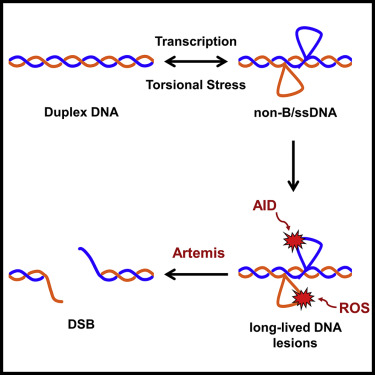Molecular Cell ( IF 14.5 ) Pub Date : 2017-12-07 , DOI: 10.1016/j.molcel.2017.11.011 Nicholas R. Pannunzio , Michael R. Lieber

|
DNA double-strand breaks (DSBs) occurring within fragile zones of less than 200 base pairs account for the formation of the most common human chromosomal translocations in lymphoid malignancies, yet the mechanism of how breaks occur remains unknown. Here, we have transferred human fragile zones into S. cerevisiae in the context of a genetic assay to understand the mechanism leading to DSBs at these sites. Our findings indicate that a combination of factors is required to sensitize these regions. Foremost, DNA strand separation by transcription or increased torsional stress can expose these DNA regions to damage from either the expression of human AID or increased oxidative stress. This damage causes DNA lesions that, if not repaired quickly, are prone to nuclease cleavage, resulting in DSBs. Our results provide mechanistic insight into why human neoplastic translocation fragile DNA sequences are more prone to enzymes or agents that cause longer-lived DNA lesions.
中文翻译:

AID和活性氧可以诱导人类染色体易位易碎区内的DNA断裂
少于200个碱基对的脆弱区域内发生的DNA双链断裂(DSB)导致淋巴恶性肿瘤中最常见的人类染色体易位形成,但是断裂发生的机制仍然未知。在这里,我们将人类的脆弱区域转移到了酿酒酵母中在遗传测定的背景下,了解在这些位点导致DSB的机制。我们的发现表明,需要多种因素的组合来使这些区域敏感。最重要的是,通过转录或增加的扭应力分离DNA链可能会使这些DNA区域受到人AID表达或氧化应激增加的损害。这种损害会导致DNA损伤,如果不能快速修复,则容易发生核酸酶裂解,从而形成DSB。我们的结果为为何人类肿瘤易位易碎的DNA序列更容易产生导致更长寿命的DNA损伤的酶或试剂提供了机械方面的见解。











































 京公网安备 11010802027423号
京公网安备 11010802027423号